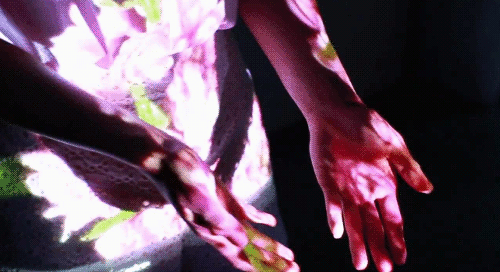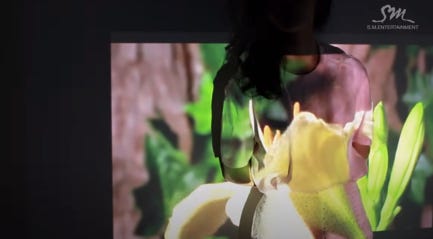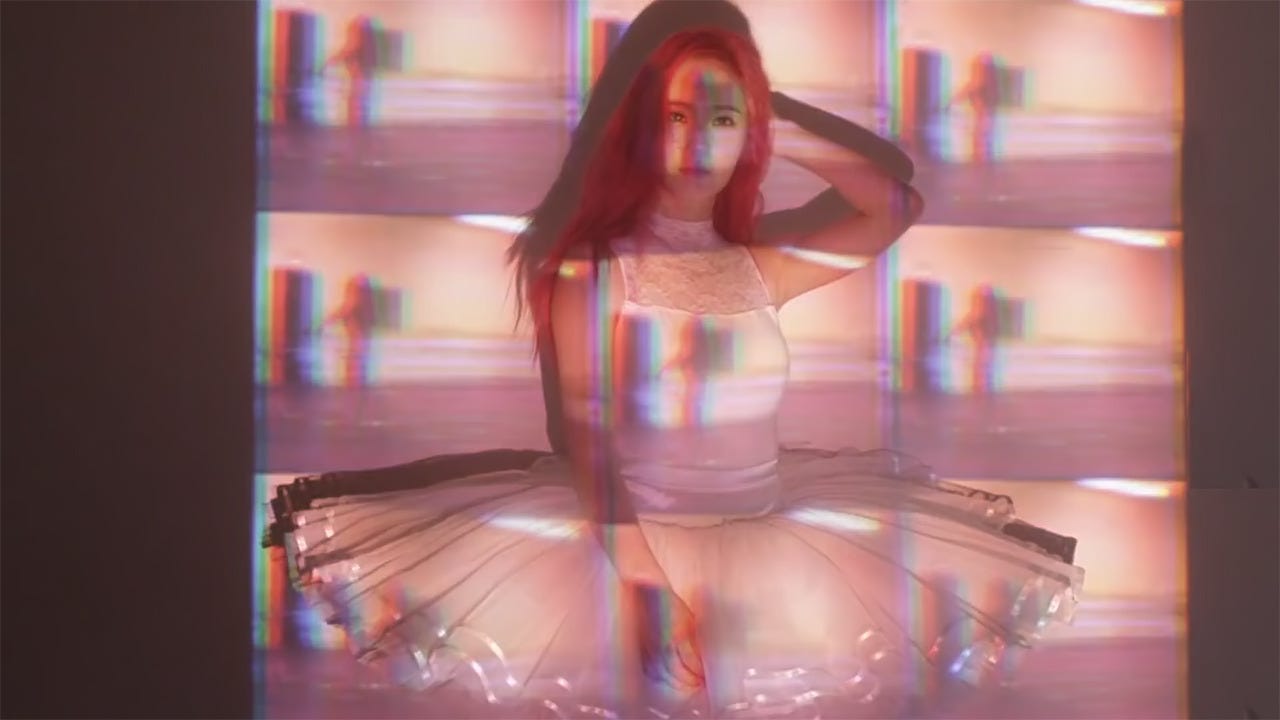Adulthood begins with a number.
Eighteen, twenty, twenty-one. A denotation that liberates the phantasms born from restless teenage nights. Visions of moonlit walks, clinking glasses, silent exchanges with strangers, bursts of adrenaline—punctuated by strange heartache—come alive with this magic number.
Such freedom is breathtaking but terrifying.
Invisible lines run across this new terrain in all directions, demarcating what you know but, more importantly, what you don’t.
It’s quite tempting to cry out “I’m lost” but you can’t.
You’re “grown up”.
A pink legend
Ten years ago, a narrative made history. This narrative upset the public’s notion of what it means to reach adulthood; awoke them from a consumerist stupor, and pushed them into a new realm of ruminative sleuthing.
Min Hee Jin’s Pink Tape art film is a legend. The film forever changed the discourse of Korean pop culture and music when it was released in 2013; f(x)’s Pink Tape subsequently won the 2014 Red Dot Award and was recognized by Billboard as one of the “greatest K-pop albums of the 2010s”. Cultural critics credit the film for revolutionizing the way in which K-pop brands build hype around their latest musical narrative.
Min’s art film was essentially a primer for f(x)’s then-upcoming Pink Tape album, and prime it did.
The two minute three second film encapsulates the excitement, the ache, the longing— the turmoil of emotions that wrack a young woman in love—coursing throughout the twelve track album. It’s a teaser that titillates, rousing just the right amount of curiosity, intermixed with confusion, in viewers. While people give up on mysteries they can’t make heads or tails of, they can’t resist cracking an enigma they think they can solve. Pink Tape’s art film is such an enigma; the film features the five f(x) members, who the public is familiar with, in abstract settings, tempting viewers to figure out the message that’s obscured beneath hallucinatory, dream-like layers.
Today we’re going to revisit this narrative masterpiece and get to the bottom of it.
Youth’s blind naivety
A feeling of impaired vision is evoked throughout the entire film, serving as a metaphor for the blind naivety that afflicts youth.
The film opens with a sequence of abstract images—a billowing curtain, leaves rattling in the wind, a burst of light in darkness, hands outstretched towards a balloon, burning incense—thrusting viewers into a state of confusion. The only clue we have to deciphering the current situation is Krystal’s soliloquy: “Love exists but with an absence of eternity…delusion that the moment will last forever…I hide behind my back and postpone all answers”. Her words convey a fear that is eclipsed by a love that excites and torments at the same time.
The darkness that pervades the screen in the first thirty seconds of the film mimic the sense of loss the girls feel upon becoming adults; they are without direction, still lingering at the edges of girlhood, eager yet hesitant to embrace the sensuality that marks the entry to adulthood. However, the girls aren’t fully comfortable with their new identities as love-stricken adults, as evinced by three devices:
a) The Lovers II reference: two f(x) members sit reclined against a mustard colored couch, leaning forward in a kiss. We don’t know who they are as they each have a white cloth swathed around their heads. This scene is a direct allusion to Réne Magritte’s The Lovers II, a surrealist painting that depicts a similarly gauzed man and woman embraced in a kiss. The layer of cloth between the two figures connotes an unbridgeable distance—no matter how close the two intertwine, their lips will never touch. Such estrangement translates to unfulfilled desires within the world of Pink Tape. The girls are drawn to love but have no idea how to approach and handle it. Such naivety results in a frustration that can be alleviated only through experience (and heartbreak).
b) Damaged film metaphor: a roll of damaged film plays against a backdrop of crinkling paper sounds, revealing glimpses of leaves and sunlight . The manner in which the film unfolds—in sporadic vertical “blinks”—recalls to mind a rapidly blinking eye struggling to see past bright light. The resulting obscurity in vision serves as a metaphor for the girls’ unsuccessful attempts to peer into the future while remaining rooted in the present. Their curiosity is not without fear though. The sound of paper being crumpled symbolizes the girls’ apprehension towards adulthood, and insinuates a readiness to abandon their pursuit of it. We’ve all had our moments of oh let’s scrap this right before crumpling up our ink stained paper—the f(x) members are likewise on an emotional pendulum that swings them back and forth from post-adolescence to adulthood.
c) Krystal’s metaphorical paper ball: the sound of crumpled up paper leads straight to a scene where red-haired Krystal pushes a paper ball into her mouth using her index and middle finger. That she uses these two fingers specifically is intended (surprise, surprise). The phallic symbolism inherent within this scene alludes to the members’ sexual awakening; the girls are now adults treading slowly through a previously barred domain where the corporeal reigns. Such erotic imagery aside, what’s noteworthy about this scene is that Krystal does not swallow the paper ball. She can’t. No matter how much she may want to repress the hodgepodge of emotions that form a whirlwind inside of her, she can’t. The impossibility of doing so intimates that Krystal, along with the other girls, will one day have to confront the emotions they currently shy away from.
The feminine mystique
For the five f(x) members, adulthood is synonymous with another similar, yet subtly different, term: womanhood.
The film features overt signs of femininity. Sulli stands barefooted with a pearl strand around her ankle and a bridal veil secured on top of her hair; Krystal poses against a pink backdrop while wearing a pompous tutu; Victoria rubs her bare legs together as if anticipating a romantic encounter. The exposure of promiscuous body parts, in tandem with figure flattering attire, corroborate the view that Pink Tape is the group’s coming of age album.
What does it mean to become a woman?
While the film sees the girls play around in feminine costumes, the clothes are simply that—costumes. Sulli’s bridal veil and Krystal’s tutu are reminiscent of children’s play. Their caricature-like outfits evoke memories of raiding our mother’s closet to find clothes that look “grown up”. What happens though when being an adult is no longer a performative act?
Femininity is defined nowhere within the film. Despite the abundance of feminine symbols and motifs, womanhood remains a mystery. The feminine figure is shrouded in a veil, quite literally. Just look at Sulli. Her wedding costume is a nod to the feminine mystique that she naturally becomes a part of. She is not the exception though. Girls who come of age automatically assume the role of “woman” without comprehending what such a label entails. Sulli illustrates this point by dropping her veil onto another member, who becomes entrapped in a box of light. The significance of this scene is two-fold. That we aren’t able to identify the other member, who sits in darkness, hints at an anonymity that is both transnational and transhistorical; young women all around the world are fated to encounter and internalize the feminine mystique. Moreover, the box of light, which creates a frame around the sitting figure, suggests that womanhood is a social construct that serves to both elevate the female status while laying down the parameters of what is acceptable to retain this mystique.
Thus, when Sulli jumps out from beneath her wedding veil, she is conveying to viewers, fans, the world, that, at heart, she is still just a young girl. Her wedding veil is a device that perpetuates the myth of a woman that embodies worldly contradictions. A woman who is tantalizingly beautiful but approachable; shy but bold; innocent but wise. Dichotomous fantasies made believable through ignorance—what can’t you believe when you know nothing about the woman in front you?
Projected gaze
f(x) are essentially a tabula rasa (aka blank slate) in the realm of adults. They have yet to establish what it means to be a young woman in their own language. Society doesn’t wait though. Society is eager to project its narrative of womanhood onto the girls.
The film transposes society’s imposing gaze into an overhead projector that beams images of flowers, opening doors, kaleidoscopic shapes and water onto the girls.
The formation of an artificial layer on top of the girls has numerous implications, which differ according to the image being projected.
a) blossoming flower: amongst the four images projected, the flower is the most explicit in its symbolic meaning. As you might guess, the flower represents youth, beauty, and fecundity. Society desires fertile women because they are only means through which it can sustain itself. Humans don’t procreate like amoebas the last time I checked. As such, the flower connotes an expectation that the girls will present themselves in an alluring manner that is more vernacularly known as “sex appeal”.
b) woman opening door: this image is a bit tricky to discern in the film, but it’s there. If you stare into the background of Krystal’s tutu moment, you’ll see that a woman is opening a door (albeit at first glance I mistook the woman to be a mailbox). The woman’s motion of opening the door reifies society’s expectation for girls to adjust swiftly to their roles as women; crossing the threshold into womanhood should be quick, just like opening and walking through a door.

c) kaleidoscope and water: the celerity with which the girls are expected to slide into their roles as women is overwhelming. Their sense of disorientation manifests in the projected images of a kaleidoscope and undulating water. We see Sulli grinning at the camera, but her face is barely visible against the kaleidoscopic patterns that run over her. The patterns radiate outwards from Sulli in rhythmical pulses that are dizzying in their symmetry; this kaleidoscopic chaos is redolent of the scene in Alice in Wonderland where Alice falls through the rabbit hole, spiraling downwards into a world where everything she knows is now upside down. Sulli finds herself in a similar position—the world she knew before is no more. She must adapt as a young woman to a familiar, yet unfamiliar world.
Amber finds herself in a similar predicament. The loneliness of her plight is emphasized by the brick walls that surround her in a dungeon-like fashion. An image of scintillating waves is projected onto the wall, lending the room a cold aura that, to an extent, reflects society’s disproving gaze towards Amber’s androgyny. Put simply, the water represents the confusion and bewilderment that Amber finds herself submerged in upon entering adulthood. The shark balloon, which she bops with her head, is a vestige of her childhood and the sole source of comfort.
Growth is resilience
Despite society’s expectant gaze, the girls don’t succumb to pressure.
They are resilient. They adapt. They grow.

We hear the girls sing “I follow you step by step (한 발 또 한 발 / 난 너를 따라가)” as one of the members takes a small step forward in neon-colored shoes. That the scene enacts the lyrics is no happenstance. Such movement intimates that the girls are willing to move forward by following in the footsteps of other brave women. Like the women before them, the girls will each carve out their own idiosyncratic version of womanhood. Krystal mediates their determination by “riding” an imaginary roller coaster into a dark tunnel that swallows her whole. This tunnel is what stands between the girls and a place where the grass is supposedly greener: consummate womanhood.
What this tunnel has in store differs for each of the girls. Despite their divergent trajectories, the girls will all have to undergo a phase of confusion and uncertainty. The slowed motion of a revolving disco ball, which reflects a dream-like splendor on its surface, alludes to the unsettling yet captivating nature of this phase.
But eventually, the girls make it through.
How do we know? Well, look at the setting.
In contrast to the dark and (in some regards) claustrophobic setting at the start, the latter part of the film brightens up considerably; the girls are seen goofing off in a yard encircled by trees. Again, it’s no coincidence that girls’ individual introductions take place outdoors; the girls are past the tunnel and now fairly comfortable in their new skins, like a selkie fresh out of the water. Krystal even goes so far as to tack a paper printed with the numbers one to five onto a tree—a gesture of triumph that signifies that all five members have emerged from the other side of the tunnel.
This isn’t to say that f(x) now know everything in the world. In fact, it’s quite the opposite. Even as young women, the five members have a lot to discover. Their ignorance is made evident by the narrow aperture of their hand-held camera, which reflects and replicates their incomplete world view. This visual technique is an iteration of the damaged film metaphor mentioned before and produces a similar effect of discomfort in viewers. Except this time, the screen’s delimiting frame is, ironically, an optimistic reference to the members’ open ended futures. The shaky, fragmented glimpses we get of the members suggest that their on-screen versions are just a fraction of the super-individuals they have the potential to burgeon into.
Oddly enough, the last image that we have of f(x) is far from adult-like. The members are dressed in a school uniform. Wait, didn’t they graduate from the tunnel? Before you start speculating wild theories, I want to direct your attention to what a school uniform represents. The ending scene is not negating the members’ transitions into adulthood. Rather, the school uniform insinuates that the members will continue to learn, evolve, and adapt throughout their lives—just like students. The journey towards growth never ends.
Aging vs. Growing
Today’s post was long. I’ll keep the conclusion short.
Pink Tape’s art film is hailed as a legend because it forced the Korean pop industry to evolve. It invented the concept of teasers, which hereinafter became the norm for both brands and fans. In the same vein, Min Hee Jin is touted as a brand mastermind because she enthralls the public time after time with new delights.
Nothing can grow forever. However, once you stop growing you start to age.
The same principle applies to brands. A brand that ceases to devise new methods of enchantment will find that it will enter a plateau-like state, which leads to cultural irrelevance and eventually, death.
As such, I want to end today with a rhetorical question: are you really grown up?

















